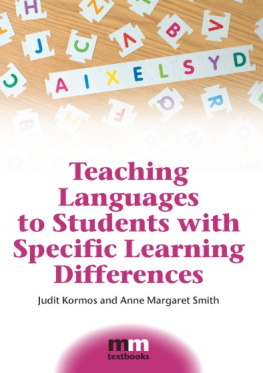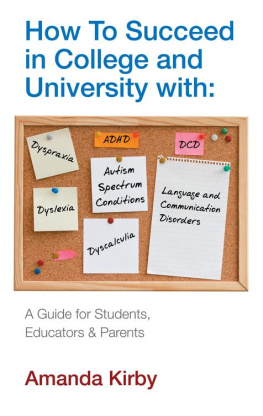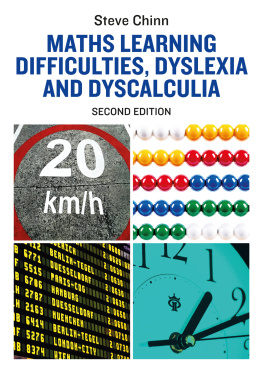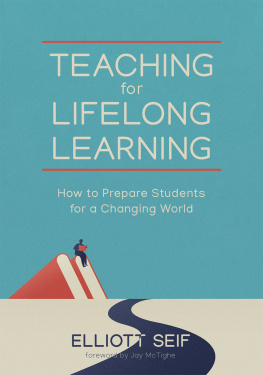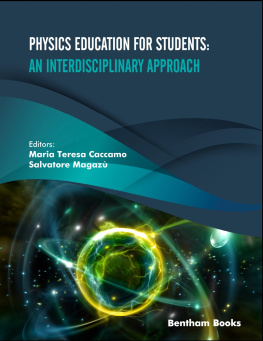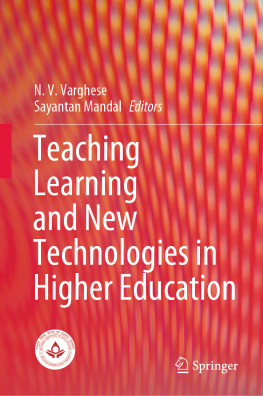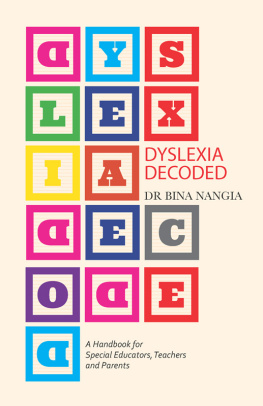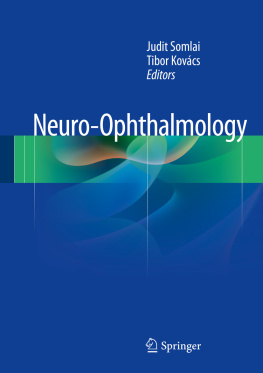Prof. Judit Kormos - Teaching languages to students with specific learning difficulties
Here you can read online Prof. Judit Kormos - Teaching languages to students with specific learning difficulties full text of the book (entire story) in english for free. Download pdf and epub, get meaning, cover and reviews about this ebook. City: Bristol;Toronto, year: 2012, publisher: Book Network Intl Limited trading as NBN International (NBNi);Multilingual Matters, genre: Home and family. Description of the work, (preface) as well as reviews are available. Best literature library LitArk.com created for fans of good reading and offers a wide selection of genres:
Romance novel
Science fiction
Adventure
Detective
Science
History
Home and family
Prose
Art
Politics
Computer
Non-fiction
Religion
Business
Children
Humor
Choose a favorite category and find really read worthwhile books. Enjoy immersion in the world of imagination, feel the emotions of the characters or learn something new for yourself, make an fascinating discovery.
- Book:Teaching languages to students with specific learning difficulties
- Author:
- Publisher:Book Network Intl Limited trading as NBN International (NBNi);Multilingual Matters
- Genre:
- Year:2012
- City:Bristol;Toronto
- Rating:4 / 5
- Favourites:Add to favourites
- Your mark:
- 80
- 1
- 2
- 3
- 4
- 5
Teaching languages to students with specific learning difficulties: summary, description and annotation
We offer to read an annotation, description, summary or preface (depends on what the author of the book "Teaching languages to students with specific learning difficulties" wrote himself). If you haven't found the necessary information about the book — write in the comments, we will try to find it.
Teaching languages to students with specific learning difficulties — read online for free the complete book (whole text) full work
Below is the text of the book, divided by pages. System saving the place of the last page read, allows you to conveniently read the book "Teaching languages to students with specific learning difficulties" online for free, without having to search again every time where you left off. Put a bookmark, and you can go to the page where you finished reading at any time.
Font size:
Interval:
Bookmark:
MM Textbooks bring the subjects covered in our successful range of academic monographs to a student audience. The books in this series explore education and all aspects of language learning and use, as well as other topics of interest to students of these subjects. Written by experts in the field, the books are supervised by a team of world-leading scholars and evaluated by instructors before publication. Each text is student-focused, with suggestions for further reading and study questions leading to a deeper understanding of the subject.
MM Textbooks
Advisory Board:
Professor Colin Baker, University of Wales, Bangor, UK
Professor Viv Edwards, University of Reading, Reading, UK
Professor Ofelia Garca, Columbia University, New York, USA
Dr Aneta Pavlenko, Temple University, Philadelphia, USA
Professor David Singleton, Trinity College, Dublin, Ireland
Professor Terrence G. Wiley, Arizona State University, Tempe, USA
Full details of all the books in this series and of all our other publications can be found on http://www.multilingual-matters.com , or by writing to Multilingual Matters, St Nicholas House, 31-34 High Street, Bristol BS1 2AW, UK.
MM Textbooks
Teaching Languages to
Students with Specific
Learning Differences
Judit Kormos and Anne Margaret Smith
MULTILINGUAL MATTERS
Bristol Buffalo Toronto
Library of Congress Cataloging in Publication Data
A catalog record for this book is available from the Library of Congress.
Kormos, Judit.
Teaching Languages to Students with Specific Learning Differences/Judit Kormos and Anne
Margaret Smith.
MM Textbooks: 8.
Includes bibliographical references and index.
1. Language and languages--Study and teaching. 2. Students with disabilities. I. Smith, Anne Margaret.
II. Title.
P53.818.K67 2012
371.9144dc23 2011048929
British Library Cataloguing in Publication Data
A catalogue entry for this book is available from the British Library.
ISBN-13: 978-1-84769-620-5 (hbk)
ISBN-13: 978-1-84769-619-9 (pbk)
Multilingual Matters
UK: St Nicholas House, 3134 High Street, Bristol BS1 2AW, UK.
USA: UTP, 2250 Military Road, Tonawanda, NY 14150, USA.
Canada: UTP, 5201 Dufferin Street, North York, Ontario M3H 5T8, Canada.
Copyright 2012 Judit Kormos and Anne Margaret Smith.
All rights reserved. No part of this work may be reproduced in any form or by any means without permission in writing from the publisher.
The policy of Multilingual Matters/Channel View Publications is to use papers that are natural, renewable and recyclable products, made from wood grown in sustainable forests. In the manufacturing process of our books, and to further support our policy, preference is given to printers that have FSC and PEFC Chain of Custody certification. The FSC and/or PEFC logos will appear on those books where full certification has been granted to the printer concerned.
Typeset by The Charlesworth Group.
Printed and bound in Great Britain by the MPG Books Group.
To Lszl, Anna and Lack, without whose support this book would not have been written.
JK
In memory of my grandmother, Marion Smith: an ESOL teacher before ESOL existed.
AMS
Whereas language learning comes easily and effortlessly to some people, many students struggle with the acquisition of languages. The cause of language learning difficulties can be manifold, but one group of people who find language learning particularly challenging are those who tend to be different in their general approach to learning from the majority of other students. In some countries these learners are seen to have a learning disability, but in this book we will show that perceiving them as different rather than deficient in certain skills and abilities helps us understand these learners better and assists in their successful inclusion in the language classroom. Around 10% of students exhibit a specific learning difference (SpLD). In other words, they have difficulties with the acquisition of literacy-related skills (dyslexia), numeracy (dyscalculia), the coordination of movement (dyspraxia), sustained attention (Attention Deficit and Hyperactivity Disorder) and social interaction (Asperger's syndrome). This means that in every learning group of 20 students, we are likely to find at least two learners who have an SpLD.
A common practice in the field of language teaching has been to exempt these students from foreign language learning on the grounds that the successful attainment of L2 competence is beyond their reach, and the time spent in the language classroom might be better used for the development of first language skills. Exemption is also often suggested to students and their parents because many language teachers feel that they lack the necessary pedagogical tools to accommodate the needs of students with SpLDs. This practice, however, seriously disadvantages students with SpLDs in today's globalized world, where proficiency in a language other than one's own first language might be as important as literacy and numeracy skills. Lack of a workable knowledge of another language might deprive students with SpLDs of equal opportunities in education, at the workplace and potentially even in their private lives. For this reason, the language teaching profession cannot continue to turn a blind eye on students with SpLDs and ignore their language learning needs.
This book is intended to help language teachers to work effectively and successfully with students who have SpLDs. To achieve this aim, we believe that teachers need to have an understanding of the nature of SpLDs and how these affect general learning processes and the mechanisms of second language acquisition. Awareness of their strengths and weaknesses and the challenges that these learners face in the academic and private domains is a prerequisite for developing supportive and caring teacher attitudes and behaviour, and for establishing an accommodating classroom environment. Additionally, language teachers need to be acquainted with the particular methods and techniques of teaching and assessment that foster success in language learning. Language teaching is also embedded in a wider social and educational context, and therefore it is important that language teachers are cognisant of the general educational issues related to identifying and disclosing disabilities and to making transitions from one institution to the other.
The book was written with different language learning contexts and with various types of learners in mind. We aimed to address situations in which another language is taught as a foreign language in the classroom, as well as cases when students from different language backgrounds get additional support in the native language of the country they reside in. We also discuss issues pertaining to teaching younger learners as well as adults. The book can form the basis of a module on a course for experienced language teachers, or be incorporated into a longer pre-service training course for novice teachers. Individual chapters could also be used independently as part of an ongoing professional development programme, or for self-study by individuals.
The book begins by exploring a range of discourses that reflect different attitudes to disability, followed by a thorough discussion of the nature and predominant features of dyslexia, dyspraxia, dyscalculia, ADHD and Asperger's syndrome, and an analysis of the specific effects they can each have on language learning. Although a range of SpLDs are discussed and named as if they were separate causes of difficulty, it should be kept in mind that in reality it is not usually possible to separate one SpLD from another. Many people who show identifiable traits of one will also experience some traits of another; the incidence of co-occurrence may be around 70% between some SpLDs. For this reason, the term SpLD is used throughout this book to denote any of the specific cognitive differences that a learner might exhibit. Occasionally, specific reference to one of the SpLDs is made in order to highlight the particular kind of difficulty that may be experienced (e.g. the kinds of difficulties with social interaction that are associated with Asperger's syndrome). Where research is reported, the authors terminology, indicating the parameters of the work, is respected. Readers may perceive that there is more attention paid throughout the book to dyslexic tendencies than to the other SpLDs; this is a function of the fact that the difficulties most commonly associated with dyslexia are those that may affect language learning most directly (e.g. phonological and visual processing difficulties).
Next pageFont size:
Interval:
Bookmark:
Similar books «Teaching languages to students with specific learning difficulties»
Look at similar books to Teaching languages to students with specific learning difficulties. We have selected literature similar in name and meaning in the hope of providing readers with more options to find new, interesting, not yet read works.
Discussion, reviews of the book Teaching languages to students with specific learning difficulties and just readers' own opinions. Leave your comments, write what you think about the work, its meaning or the main characters. Specify what exactly you liked and what you didn't like, and why you think so.

